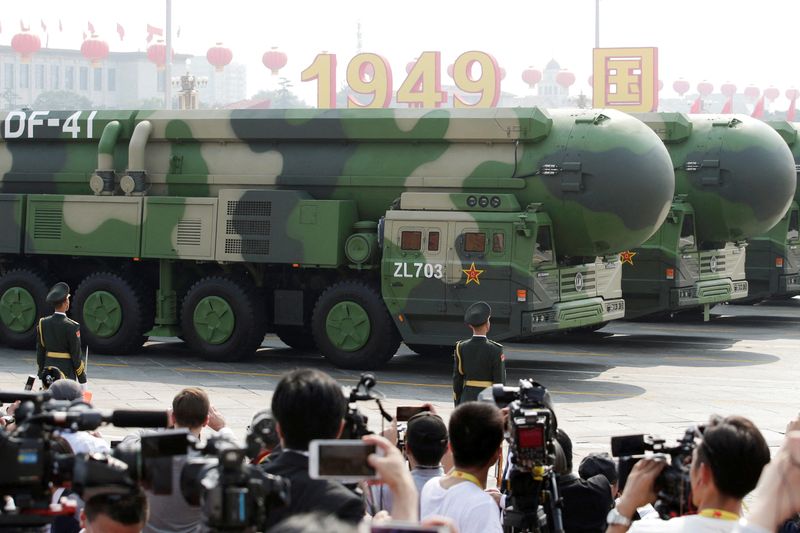By Greg Torode
HONG KONG (Reuters) - From a missile discreetly ferried more than 1,000 km (620 miles) to a launch site, to the use of remote bases and satellites to track it from Hainan Island to the South Pacific, China's September ICBM flight marked a test of operational necessity.
Six security analysts and four diplomats evaluating the Sept. 25 launch said that although the rare test carried political messaging amid China's nuclear weapons buildup, it also met a long-overdue need for the People's Liberation Army's Rocket Force to ensure its nuclear deterrent worked as advertised.
Strategic diplomacy was also part of the drill, with Beijing notifying the United States, France and New Zealand ahead of the launch but some analysts warn more will be needed if China is eyeing a more intense missile testing regime to catch up with rivals.
Australia, advised hours before the launch of a planned activity but given no details, is among Pacific nations raising concerns with China and calling for an end to ballistic missile testing in the region.
"This enabled the Chinese to carry out a test with a full attack profile," said Hans Kristensen, the director of the Federation of American Scientists' Nuclear Information Project. "In operational terms, this is inevitably an important step ... the test represents the operational validation of the entire system."
In recent years, the Rocket Force has tested extensively, flying about 135 ballistic missiles in 2021, according to the Pentagon, mostly into China's isolated deserts.
But not since 1980 has it fired its longest-range missiles on a more realistic attack trajectory, similar to the tests carried out routinely by the United States, Russia and India.
Although Western militaries believe China has boosted the quality and quantity of its warheads, missiles and silos in recent years, only full-range tests can gauge the accuracy and reliability of a ballistic missile and its warhead, given the stresses and distances involved.
Such a test over the ocean would have been monitored by China's evolving network of satellites and space tracking sites and ships, including on its islands in the disputed South China Sea and in Namibia and Argentina, diplomats and analysts said.
Two of China's most advanced "space support" ships, the Yuan-wang 3 and the Yuan-wang 5, were in the Pacific at the time, according to ship tracking data viewed by Reuters. The Yuan-wang 3 was sailing northwest of Nauru while the Yuan-wang 5 was east of the atolls of Tokelau.
China's defence ministry has not specified where the missile landed, saying in a statement that the dummy warhead "fell into expected sea areas".
The ministry did not respond to requests for comment.
Although some analysts say the U.S. deployed surveillance aircraft to track the missile, the precise launch and landing locations have not been publicly released.
Media in French Polynesia reported the missile landed near to the French Pacific territory's exclusive economic zone, more than 11,000 km (6,800 miles) from Hainan.
Timothy Wright, a missile researcher at the London-based International Institute for Strategic Studies, said the test gave the PLA a "great opportunity" to evaluate how well it could track long missile flights.
"China's network of satellites, ground stations and tracking ships is still evolving, and there are question marks over just how effective its space-based ISR capabilities are," Wright said, referring to intelligence, surveillance and reconnaissance.
NEXT STEPS
For this test, the PLA relied on its one of its older ICBMs, a DF-31, some analysts noted. Launching it from Hainan allowed a trajectory that mostly avoided other nations, they said.
The closest DF-31s to Hainan are based 1,100 km (684 miles) away in Yibin, in Sichuan province on the Chinese mainland, under the control of a Rocket Force unit linked to one on Hainan, some analysts said.
Tests from hinterland silos over north Asia or over the Arctic to the North Atlantic would be more geographically and diplomatically complex.
Japan and the Philippines were notified of possible space debris landing at sea, but some Pacific Island nations closer to the landing zone were not informed by China, two diplomats said. On Tuesday, Kiribati's president criticised the test, saying the country got no prior notification.
A New Zealand foreign ministry spokesperson told Reuters that after they were informed, Wellington reached out to Pacific island partners.

Singapore-based China security scholar James Char said Beijing would most likely be cautious about negative reactions to frequent launches, and would be wary of opening itself up to surveillance from rivals.
"We can be dead sure Beijing is more than careful when it comes to guarding the true nature and extent of its military capabilities," said Char, of the S. Rajaratnam School of International Studies.